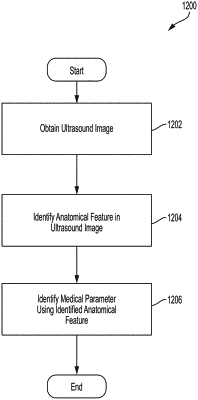| CPC G06V 10/82 (2022.01) [A61B 8/02 (2013.01); A61B 8/06 (2013.01); A61B 8/065 (2013.01); A61B 8/085 (2013.01); A61B 8/4427 (2013.01); A61B 8/46 (2013.01); A61B 8/52 (2013.01); A61B 8/5207 (2013.01); A61B 8/5223 (2013.01); G06F 18/24133 (2023.01); G06T 7/0012 (2013.01); G06T 7/0014 (2013.01); G06T 7/70 (2017.01); G06T 11/60 (2013.01); G06T 19/006 (2013.01); G06V 10/454 (2022.01); G06V 30/194 (2022.01); G06V 30/19173 (2022.01); G06V 40/67 (2022.01); A61B 8/0833 (2013.01); A61B 8/0883 (2013.01); A61B 8/4263 (2013.01); A61B 8/463 (2013.01); A61B 8/5215 (2013.01); A61B 2034/2065 (2016.02); A61B 2090/365 (2016.02); A61B 2090/378 (2016.02); A61B 2090/3937 (2016.02); G06T 2207/10132 (2013.01); G06T 2207/20081 (2013.01); G06T 2207/20084 (2013.01); G06T 2207/20221 (2013.01); G06T 2207/30048 (2013.01); G06T 2207/30061 (2013.01); G06T 2210/41 (2013.01); G06V 2201/03 (2022.01)] | 14 Claims |

|
1. A system, comprising:
an ultrasound device configured to capture an ultrasound image of a subject, wherein the ultrasound device comprises a plurality of ultrasonic transducers; and
a processor configured to:
receive medical information about the subject,
identify a target anatomical view of the subject to image based on the received medical information about the subject, and wherein the identified target anatomical view is a parasternal long axis view of the subject to image and has been identified as the target anatomical view based on the received medical information about the subject indicating that subject has experienced paroxysmal nocturnal dyspnea,
obtain the ultrasound image of the subject wherein the ultrasound image contains the target anatomical view,
identify a location of at least one anatomical feature in the ultrasound image using a deep learning technique;
identify at least one medical parameter of the at least one anatomical feature at least in part by analyzing the ultrasound image, wherein the at least one medical parameter comprises an ejection fraction of the subject identified based on the medical information about the subject indicating that the subject has experienced paroxysmal nocturnal dyspnea;
produce an alert if the ejection fraction of the subject varies by more than a threshold amount from a baseline, and
determine that the ejection fraction of the subject is below a threshold and based at least in part on determining that the ejection fraction of the subject is below the threshold, recommend treatment of angiotensin-converting-enzyme inhibitors (ACE inhibitors) and/or angiotensin receptor blockers (ARB).
|